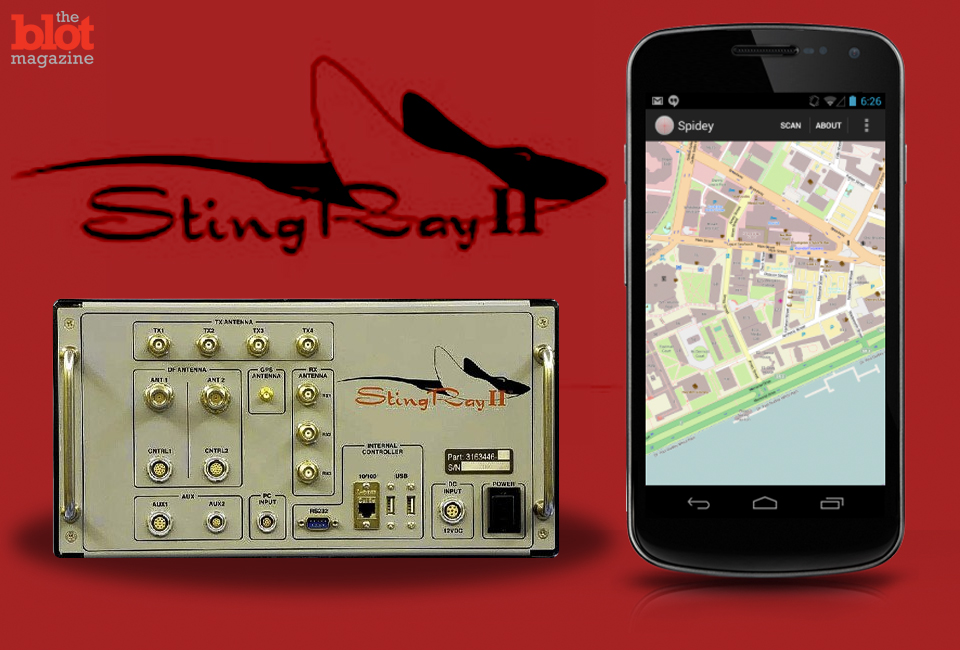
Want to know if your cellphone is being spied on by police? There will soon be an app for that.
A group of students and activists are working on “SpideyApp,” an Android program that alerts users to the presence of potential cellphone surveillance equipment including a controversial tool used by local and state police known as a StingRay.
StingRays are portable devices that mimic the activity of a legitimate cellphone tower. When deployed by police, a StingRay forces all phones within a given radius to connect to it instead of an actual tower. Once connected, police can pull various metadata from a phone, including call logs, text message information and geolocation data.
Harris Corporation, the manufacturer of the StingRay and other spy gear, has gone to great lengths to keep information about the surveillance device from the public. Local law enforcement have been complicit in these requests, often citing non-disclosure agreements as a reason why officers deployed StingRays without first obtaining a warrant. In at least one local court case, the FBI sought to block the release of court transcripts detailing the use of a StingRay device against a criminal defendant (a judge ruled against them, and the testimony was released).
LINK: View TheBlot Magazine’s ongoing coverage of StingRay spy devices
The clandestine use of StingRays caught the attention of Jeffrey Warren, a computer science fellow at the Massachusetts Institute of Technology (MIT). Earlier this year, Warren collaborated with Kade Crockford of the American Civil Liberties Union (ACLU) and Nathan Freitas of the Guardian Project to develop SpideyApp as part of a project for MIT’s Center for Civic Media.
SpideyApp works by scanning an area for all cellphone towers within range. It catalogues the found towers on a map and in a database stored on the phone. Over time, SpideyApp conducts additional scans, then compares the results to previous ones. The user is alerted to any abnormalities, such as the sudden appearance or disappearance of a tower or if a tower has moved from one location to another. Such abnormalities could be indicative of a StingRay or similar device.
“Most people don’t know where their towers are,” Freitas said in a phone interview with TheBlot Magazine. “[With SpideyApp], if you’re curious about what’s there, you could measure it every day and see what happens.”
Scanned data can be shared by e-mail or posted on social media so that other users can compare it to their own scans. In the future, Freitas says SpideyApp could even provide users with a real-time map on where cellphone towers are and if any have moved or disappeared (“It’s totally technically feasible to do this,” Freitas says).

In addition to surveillance, Freitas says the app could be used in situations where local authorities order the shut down of cellphone networks during civil demonstrations and protest. This isn’t unheard of: San Francisco’s mass transit system shut off cellphone networks ahead of an anticipated protest in Aug. 2011, triggering local criticism and an investigation by the Federal Communications Counsel (FCC).
“The idea that the cell network can be messed with — not only is it tracking you, but it can be turned off … the ACLU knows this is wrong, but they don’t have any way of knowing when it’s happening,” Freitas says. “That’s one of the problems they see — it’s not a tangible thing to people because it’s so invisible.”
SpideyApp’s creators believe their software solves that problem and hopes the app will generate greater discussion about law enforcement tactics surrounding clandestine cellphone manipulation. But the app isn’t limited to spying: Freitas notes that the app could play a great role in civil emergencies like earthquakes and hurricanes where scanned data could provide a public service in determining which cellphone networks are available and which are down. And Warren notes that the app could be used to thwart criminals who seek to steal credit card numbers and passwords with homemade StingRay-like devices.
SpideyApp’s source code is currently available on GitHub. Freitas says developers are hoping to release the app publicly later this fall (current plans call for an Android-only release; Freitas notes that a similar app can’t currently be developed for the iPhone because of Apple-imposed technical restrictions). Interested Android users can sign up here to be notified once the app is released.
Matthew Keys is a contributing journalist for TheBlot Magazine.




